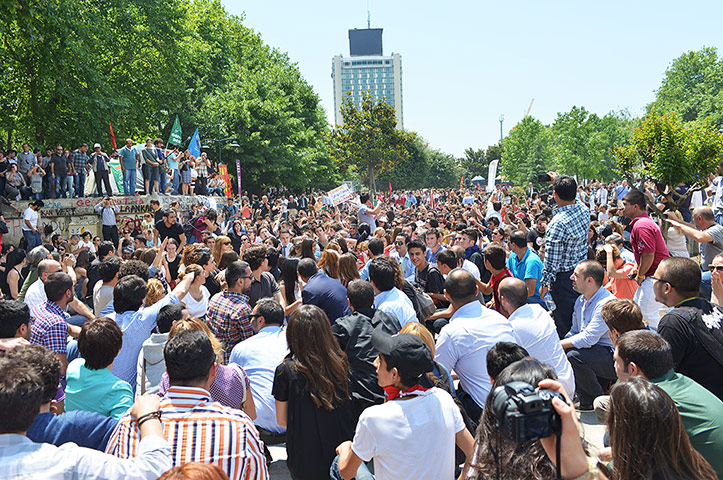 |
| Protesters fill the streets in Rio de Janeiro. Source: The Guardian |
"The voices of the street want more citizenship, health, transport,
opportunities...": so said Brazilian President Dilma Rousseff, in
response to several days and nights of protests by hundreds of thousands
of people across a number of cities in Brazil.
I'm currently in the middle of writing a piece in response to Paul Mason's book
Why It's Still Kicking Off Everywhere for
City ... and while I've got my issues with some bits of the book, it's also hard not see recent events in Turkey and now in Brazil as further evidence to support some of his claims about the manner in which things are indeed still 'kicking off' in lots of places as various crises unfold.
Of course, as Mason is first to admit, different instances of contemporary mass protest each demand their own analysis. In Brazil, the grievance that seems to have been the spark for protests was a raise in bus fares, but clearly the protesters are articulating wider grievances about policing, public services, and spending on the up-coming Football World Cup (would it be wrong for me to say '
Go, Socceroos!' at this point?)
So, as with the recent post on Turkey, here are a few quick links to follow for some more information and analysis.
As ever, the
Guardian has been a great source of information for me: you can find a page with links to their coverage of the protests, including reportage, analysis, and pictures/videos
here.
Marcelo Lopes de Souza, a Professor in the Department of Geography at the Federal University of Rio de Janeiro, has been publishing some of his work on insurgent social movements in Brazilian cities in English in
City and elsewhere. In his 2012 piece for
City "
Panem et Circenses or The Right to the City (Centre) in Rio de Janeiro" is a great piece for understanding the source of tensions about policing, spending, and displacement that now seem to be spilling onto the streets. He notes in that piece that:
In Rio de Janeiro, the dispute between the favela
residents and the sem-teto [squatter] movement on the one side, and the interests linked
to the ‘revitalisation’ of the harbour and down-town areas on the other,
currently has everything to do with the municipal administration’s gradual
implementation of the ‘revitalisation’ project christened Porto Maravilha (‘Marvellous
Port’) along with the ‘slum upgrading’ programme Morar Carioca. The implementation
of both the Porto Maravilha project and the Morar Carioca programme is taking
place in the context of a very repressive policy named by the municipality as Choque
de Ordem (‘Shock of Order’).
What is in fact going on is the fostering
of gentrification and increasing social control on a large scale within the
framework of a very conservative urban regime, supported by the state
government of Rio de Janeiro and even by the self-professed left-wing federal
government under both President Lula da Silva (2003 – 10) and President Dilma
Rousseff (2011 – present). The situation has become increasingly tense since 2009.
For a while now, I've also been meaning to blog about James Holston's 2009 piece "
Insurgent Citizenship in an Age of Global Urban Peripheries". It's kinda awesome. I still hope to write on it in more detail at some point ... but in light of recent events in Brazil and beyond, it seemed appropriate to share this passage:
"although insurgent urban citizenships may utilize central civic space and even
overrun the center, they are fundamentally manifestations of
peripheries. In so far as the urban civic square embodies an idea of
centrality and its sovereignties, its architectural design,
institutional organization, and use represents the hierarchies,
legalities, segregations, and inequalities of the entrenched regime of
citizenship that the insurgent contests. The forces of centrality are
entrenched in the civic square by design and that entrenchment
establishes the terms of an official public sphere. Insurgent movements
may adopt these terms to frame their protests—property rights, urban
infrastructure, justice, even motherhood, for example. But whereas the
center uses the structuring of the public to segregate the urban poor in
the peripheries and to reduce them to a “bare life” of servility, the
very same structures of inequality incite these hinterland residents to
demand a life worthy of citizens.
My point is that it
is not in the civic square that the urban poor articulate this demand
with greatest force and originality. It is rather in the realm of
everyday and domestic life taking shape in the remote urban peripheries
around the construction of residence. It is an insurgence that begins
with the struggle for the right to have a daily life in the city worthy
of a citizen’s dignity. Accordingly, its demands for a new formulation
of citizenship get conceived in terms of housing, property, plumbing,
daycare, security, and other aspects of residential life. Its leaders
are the “barely citizens” of the entrenched regime: women, manual
laborers, squatters, the functionally literate, and, above all, those in
families with a precarious stake in residential property, with a legal
or illegal toehold to a houselot somewhere far from elite centers. These
are the citizens who, in the process of building and defending their
residential spaces, not only construct a vast new city but, on that
basis, also propose a city with a different order of citizenship.
Both pieces above examine the nature of centre-periphery relationships in urban life in Brazil. I'm nowhere near educated enough to know just who has hit the streets in the past few days and whether they are from the 'peripheries' ... but the centres are certainly being overrun, to powerful effect. What kind of jolt might this produce in Brazilian politics?
[Note 1: of course, neither author considers the 'periphery' to be a simple geographical designation...]
[Note 2: if you can't access full copies of these articles, get in touch...]



































